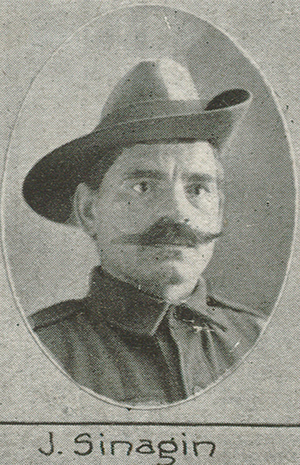Gregory Smagin
| Alias | George |
|---|---|
| Russian spelling | Григорий Смагин |
| Born | 30.12.1875 |
| Place | Eniseisk, Russia |
| Ethnic origin | Russian |
| Religion | Roman Catholic (?) |
| Family | Wife Ekaterina Smagin, stayed at Eniseisk, Russia; Wife Ekaterina Smagin (nee Stebrina), married 1925, Queensland |
| Arrived at Australia |
from Far East on 16.10.1914 per St Albans disembarked at Brisbane |
| Residence before enlistment | Townsville, Qld |
| Occupation | Labourer |
| Naturalisation | 1923 (file was not found) |
| Residence after the war | 1918 Brisbane, 1921 Cairns, Innisfail, 1927 Innisfail, Qld |
| Died | 4.03.1962, Cairns, Qld |
Service #1
| Service number | 2196 |
|---|---|
| Enlisted | 3.04.1915 |
| Place of enlistment | Townsville, Qld |
| Unit | 15th Battalion, 11th FAB, 4th DAC |
| Rank | Private, Gunner |
| Place | Gallipoli, 1915; Western Front, 1916-1918 |
| Final fate | RTA 23.09.1918 |
| Discharged | 12.12.1918 |
Materials
Digitised service records (NAA)
Digitised Embarkation roll entry (AWM)
Alien registration (NAA)
Application for admission of relatives (NAA)
Medical case file (NAA)
Blog article
Newspaper articles
Russians disagree. £100 damages claimed. - The Brisbane Courier, 17 May 1929, p. 3
Innisfail Russians. Exchange of courtesies. Assault and battery charge. - Cairns Post, 17 May 1929, p. 7
Fighting Russians. Innisfail interlude. New trial application - Cairns Post, 4 June 1929, p. 9
Russian diversion. New trial refused. - Cairns Post, 10 June 1929, p. 9
From Russian Anzacs in Australian History:
Russians who joined the army together, or who met up at training camp, would often embark together. [...] The Karoola, which left Brisbane on 12 June 1915, carried eight Russians mostly from northern Queensland: Glowacki, Roomianzoff, Sekachoff, Karelin (6/9th Battalion), and Lopaten, Grehoff, Smagin and Volkoff (6/15th Battalion). In Sydney they were joined by three of their countrymen -- Kozakoff, Harbert and Kozakovshonok.
[...] It seems that only two of the Russians -- John Wagin, an articulate champion of workers' rights, and Gregory Smagin, who spoke through an interpreter -- managed to make the military listen to their arguments [about their discharge after Russia's withdrawal from the war]. Instead of deserting, they paraded themselves to their commanding officers on 29 July 1918, but were both arrested. The two men served in different units of the 4th Division, and probably coordinated their actions. [...] Smagin fought with the 15th Battalion at Gallipoli and then re-qualified as a gunner, and had a spotless record of service with the 4th Division Ammunition Column. To his commanding officer, he said: 'British fight Russia. I fight no more for the British. Smagin finished soldering.' On being interrogated, he stated that his wife in Krasnoyarsk received no assistance from either the Australian or Russian governments and argued, 'I consider I should obtain my discharge under the circumstances surrounding the fact that Russia has made peace with Germany. I also understand that the British in the Russian Armies have been discharged.' Smagin was put under close arrest while his commanding officer made enquiries at divisional headquarters. [...]
[...] At the end of August [1918] Smagin was transferred to England, without trial, for return to Australia. His case set the ball rolling: a month later four other Russians, from 4th Division artillery units, were also sent back to Australia 'on account of Russian nationality'. They were followed by another five men from different units, sent back under the same rubric; though sometimes it was recorded as 'other reasons' or 'family reasons'. There are some familiar names among them: John Wagin (who had just been sentenced to six months' imprisonment with hard labour), Michael Osipoff (who had earlier wounded himself), Alexis Kazakoff (who some months previously refused to serve as a gunner), and Justin Glowacki.
Gallery

Gregory Smagin
Queenslander Pictorial, supplement to The Queenslander, 29 May 1915, p. 23
 Russian Anzacs
Russian Anzacs